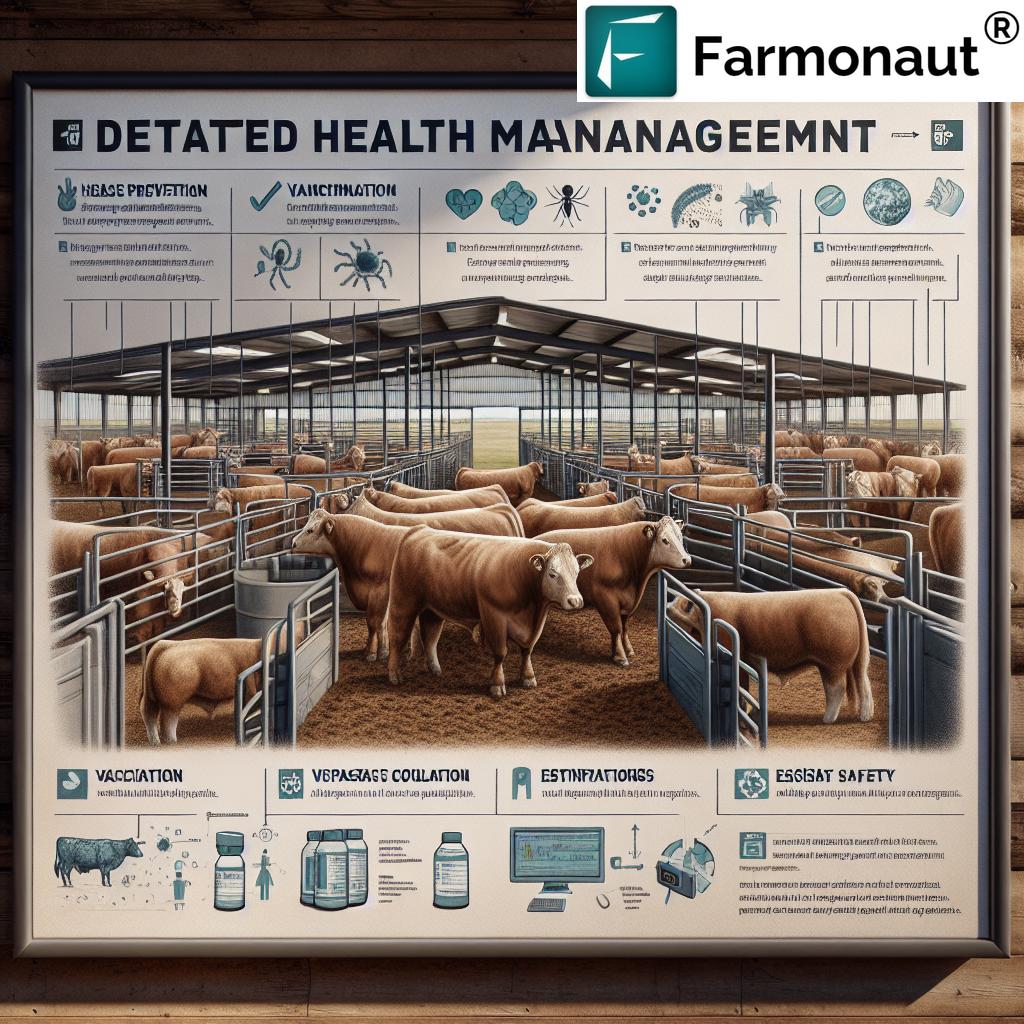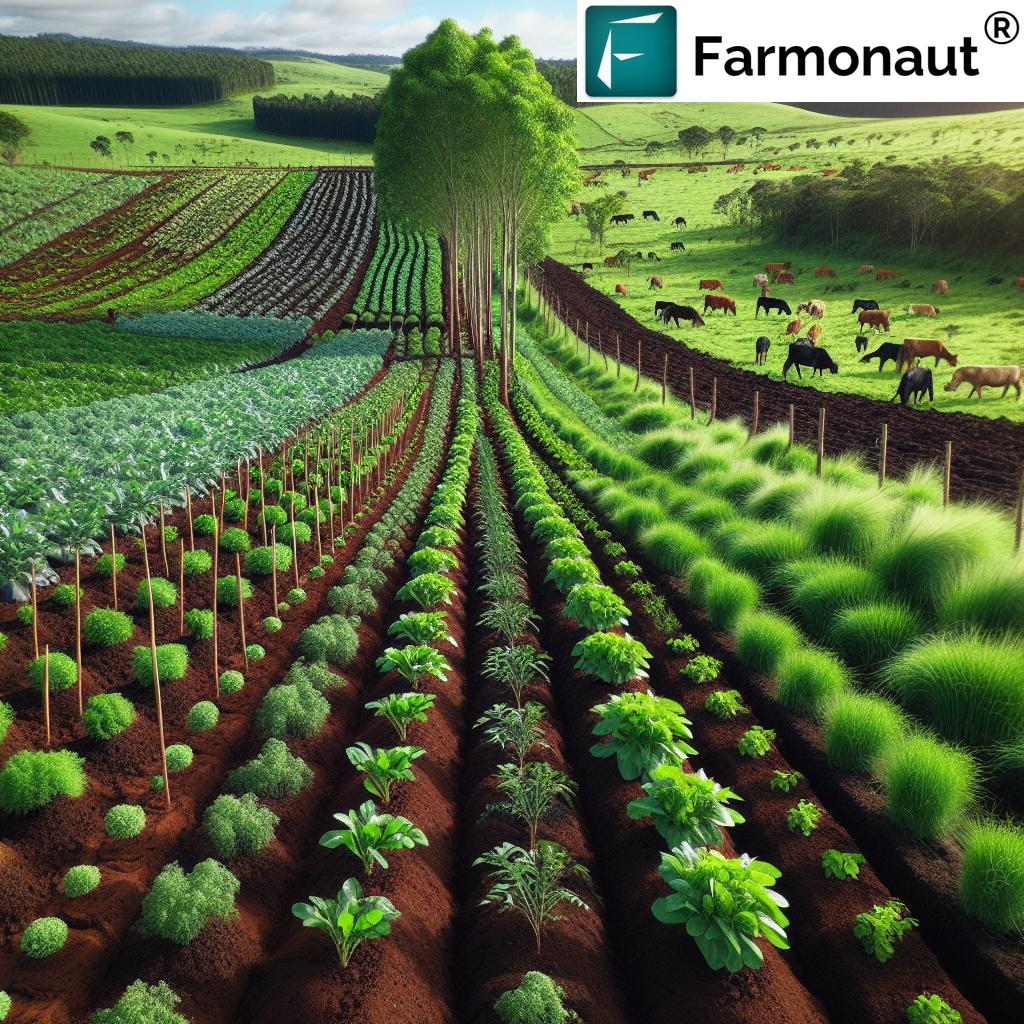Cattle Ranch Management: 7 Genius Hacks for Huge Profits
Table of Contents
- Summary: The Multifaceted Art of Cattle Ranch Management
- Trivia: Rotational Grazing and Productivity
- 1. Grazing Management Strategies
- 2. Herd Health Management
- 3. Infrastructure Maintenance
- 4. Financial Planning for Ranchers
- 5. Sustainable Livestock Production Practices
- 6. Ranch Technology Solutions
- 7. Data-Driven Decision-Making & Record-Keeping
- Cattle Ranch Management Hacks: Benefits & Estimated Profit Gains
- Trivia: The Impact of Herd Health Management
- Harnessing Farmonaut for Smarter, Greener Ranching
- Frequently Asked Questions
- Farmonaut Subscription Plans
Cattle ranch management stands as a dynamic discipline, integrating time-tested livestock practices with modern technology and environmental consciousness. At its core, ranch management involves much more than tending to animals—it’s about striking the optimum balance between productivity, sustainability, and economic viability.
We must focus on effective grazing management strategies, proactive herd health management, solid infrastructure maintenance, financial planning, and the strategic adoption of innovative technology. By implementing these comprehensive methods, we not only maximize profits but also reinforce environmental stewardship for future generations.
“Rotational grazing can boost pasture productivity by up to 30%, supporting sustainable cattle ranch management.”
1. Grazing Management Strategies: The Foundation of Ranch Productivity
A key pillar of cattle ranch management is the way we manage pastures and forage resources. Effective grazing management strategies boost productivity, animal health, carbon sequestration, and overall environmental sustainability. Let’s dive into proven methods and their far-reaching benefits.
Understanding Rotational Grazing vs. Continuous Grazing
- Rotational Grazing: Cattle are systematically moved between different pasture plots, giving plants time to recover and regrow (rotational grazing benefits).
- Continuous Grazing: Cattle have unrestricted access to the same area for an extended period, which can lead to overgrazing and soil degradation.
The rotational grazing method boosts pasture productivity and supports plant diversity by protecting forage plants and allowing essential root development. This approach fosters resilient ecosystems and improves natural carbon sequestration, directly impacting the soil’s health and our ranch’s economic viability.
For ranchers aiming for sustainable livestock production, rotational systems are proven to:
- Prevent soil erosion and excessive compaction
- Reduce weed pressure and reliance on chemical herbicides
- Support plant diversity and increase available forage quality
- Improve water retention and reduce run-off
- Maximize livestock numbers without risking overgrazing
- Increase overall long-term pasture health and carrying capacity
Implementing an Effective Rotation System
- Divide large grazing areas into smaller, manageable paddocks.
- Monitor: Regularly assess forage height, soil moisture, and animal impact on each paddock.
- Rotation Timing: Move cattle based on pasture regrowth (not fixed deadlines). Generally, 2-4 weeks in one paddock is ideal, depending on forage growth rates.
- Rest Periods: Allow 30-45 days of rest, but adjust for local climate and pasture species.
- Water Access: Position portable or permanent water systems to ensure cattle always have access, but avoid damaging stream banks.
- Record-Keeping: Utilize data and apps (like Farmonaut, described below) to track patterns and optimize movements.
By integrating rotational grazing strategies, we create a sustainable feedback loop—healthy pastures sustain healthy cattle, which in turn leads to increased productivity and profits.
Beyond the Basics: Continuous Grazing Risks
- Overgrazing: Pasture plants lack recovery time, reducing density and resilience
- Lower Forage Quality: Only hardy, less nutritious plants tend to survive
- Reduced Livestock Capacity: Fewer cattle can be supported over time
- Soil Degradation: Increases in compaction and erosion, leading to poorer water retention and increased stress on infrastructure
Best Pasture Management Practices
- Utilize multi-species forage blends to extend grazing seasons and increase nutritional diversity.
- Adopt regular soil health monitoring, using tools like Farmonaut’s satellite-driven analyses to check soil moisture, carbon sequestration metrics, and plant vigor (see carbon footprinting solutions).
- Practice adaptive management: Adjust paddock sizes and rotation schedules based on rainfall, temperature, and livestock numbers each season.
2. Herd Health Management: Optimize Animal Welfare & Reduce Financial Losses
Effective herd health management is foundational for every successful ranch operation. Keeping cattle healthy isn’t just about animal welfare—it’s about optimizing productivity, reducing unnecessary costs, and ensuring sustainable livestock production.
Comprehensive Herd Health Programs
- Vaccination Schedules: Establish annual vaccination plans based on regional disease risks and expert recommendations.
- Parasite Control: Integrate internal (e.g., wormers) and external (e.g., fly tags, dips) parasite management programs; rotate types to avoid resistance.
- Routine Health Assessments: Physically examine livestock for signs of stress, lameness, and early stages of diseases every few weeks.
- Biosecurity Measures: Quarantine new or returning animals, sanitize handling facilities, and limit ranch access during outbreaks.
- Nutrition Optimization: Work with an animal nutritionist to tailor feed supplementation according to pasture quality, cattle age, and production stage.
By investing in these preventative livestock disease management measures, we can dramatically reduce the incidence of disease and parasitic infection, supporting higher weight gains, better reproductive success, and overall economic profitability.
Livestock Disease Prevention: Disease Screening & Response
- Set up facilities for safe capture and handling during routine disease assessments
- Implement a clear protocol for isolating sick animals
- Record every disease event and track response outcomes
- Leverage digital herd health management tools for real-time updates and alerts (Farmonaut’s platform offers farm resource monitoring and AI-based health advisory for this purpose)
“Proper herd health management reduces disease outbreaks by 40%, ensuring higher profits and environmental sustainability.”
3. Ranch Infrastructure Maintenance: Backbone of Efficient Operations
We cannot overstate the significance of robust ranch infrastructure maintenance for hassle-free cattle management. From fencing to water distribution, infrastructure underpins both animal welfare and our daily ranch operations.
Essential Ranch Facilities & Systems
- Perimeter and Interior Fencing: Prevent livestock escape, manage rotational grazing, and protect sensitive areas (use high-tensile and electric fencing for durability).
- Water Systems: Install freeze-resistant water tanks and troughs, powered by solar pumps when possible. Test water quality quarterly for minerals and contaminants.
- Handling Facilities: Chutes and corrals ensure safe handling for vaccinations, weighing, and sorting; design with smooth curves to minimize cattle stress.
Infrastructure Inspection and Upgrades
- Set monthly or seasonal infrastructure inspections for fencing, water lines, troughs, and shelters
- Maintain an inventory log of all maintenance work (digital systems are preferred)
- Repair promptly to prevent costly downtimes or animal safety risks
- Invest in high-quality, environmentally friendly materials (recycled posts, solar pumps)
The use of drone technology and satellite monitoring platforms, such as Farmonaut, allows us to survey vast areas quickly and detect issues proactively. For instance, satellite tools can reveal failing fencing lines, water leaks, or encroaching weeds—all crucial for reducing labor and maintaining optimal productivity.
Check out Farmonaut’s fleet and resource management tools to enhance the maintenance and utilization of ranch infrastructure.
4. Financial Planning for Ranchers: Maximize Your Economic Viability
Astute financial planning for ranchers is the linchpin of sustainable and profitable ranch operations. Adopting data-driven budgeting and record-keeping transforms economic guesswork into strategic foresight.
Comprehensive Financial Record-Keeping
- Track livestock performance: Monitor birth rates, weight gains, reproductive success, and culling ratios
- Forage Production Records: Assess pasture yield per paddock and correlate rain, fertilizer, and livestock use
- Budgeting: Detail annual costs for feed, health care, maintenance, labor, and infrastructure
- Economic Indicators: Calculate return on investment (ROI) per animal and per acre/paddock
- Loan and Insurance Management: Document lending and insurance coverage; Farmonaut’s
crop loan & insurance verification tools
reduce risk and streamline approvals via satellite-based validation
Leveraging Technology for Financial Performance
- Deploy digital farm management systems and mobile apps for automated record-keeping
- Integrate satellite data to monitor real-time pasture productivity and optimize input costs
- Utilize benchmarking to compare herd and pasture performance year-over-year
With Farmonaut’s scalable API (official API here) and well-documented developer documentation, large-scale ranchers can link satellite observations directly to internal accounting and budgeting applications for real-time insights.
5. Sustainable Livestock Production Practices: Safeguard Tomorrow’s Ranch
Championing sustainable livestock production practices means we look beyond seasonal profits to the long-term health of our land, livestock, water, and business. By combining traditional wisdom with science-based methods, our ranch not only survives—it thrives.
Regenerative Soil and Pasture Management
- No-till Pasture Renovation: Restore worn areas with drill-seeded perennial grasses and forbs, minimizing soil disturbance and increasing resilience
- Cover Cropping: Use fast-growing annuals during rest periods to reduce erosion, boost organic matter, and increase grazing options
- Composting: Transform livestock manure and bedding into organic fertilizer, closing the nutrient loop on the ranch
Water Management for Resilient Ranches
- Solar-Powered Water Systems: Minimize fossil fuel dependence and extend water access in remote pastures
- Rainwater Harvesting: Install rooftop or field-edge collection tanks—use this sustainable approach for livestock hydration, cleaning, and minor irrigation
- Riparian Buffer Zones: Protect waterways with fenced-off native plant strips to filter runoff and prevent pollution
Sustainability doesn’t just protect the land—it brings practical and financial advantages by reducing costs (less synthetic input use, lower water bills), enhancing livestock health (cleaner water, richer pasture), and improving our environmental footprint.
Measuring and Tracking Sustainability
- Use Farmonaut’s carbon footprinting module to track emissions and sequestration for compliance, marketing, and internal goals.
- Adopt blockchain-based traceability (see product traceability platform) for responsible beef/livestock marketing.
6. Ranch Technology Solutions: Boost Efficiency with Smart Innovations
Today’s leading cattle ranch management operations are leveraging state-of-the-art technology to drive major gains in efficiency, decision-making, and profitability. Embracing these solutions not only increases output, but supports sustainability and transparency throughout our production process.
Must-Have Ranch Technologies
- Satellite Monitoring with Farmonaut: Leverage multispectral imagery for real-time assessment of pasture health, soil moisture, and livestock distribution
- Sensor Networks: Use IoT-based water level, fence integrity, and gate sensors for automated alerts and reduced labor
- Precision Fencing Systems: Remote-controlled electric fencing for easy rotation and quick repairs
- Drones: Aerial surveys to quickly spot grazing patterns, water issues, or infrastructure failures
- Data Analysis Software: Integrate weather, satellite, and operational data to model optimal grazing schedules and economic scenarios
Farmonaut: Affordable Precision & Accessibility
- Real-Time Crop and Ranch Monitoring: Accessible through Android, iOS, browser app, or via API for seamless integration
- AI-powered Advisory (Jeevn): Personalized, regional recommendations in your favorite language, with weather-based analytics and pest management alerts
- Blockchain Traceability: Ensure every product can be traced from ranch to consumer, trusted by corporate brands—improving transparency on Farmonaut Traceability Platform
Explore enterprise-scale options for managing vast operations or plantations with Farmonaut’s large-scale farm management tools.
For developers and integrators, see the API and API developer docs.
Example Use Cases and Benefits
- Identify and mitigate overgrazed patches before yield reductions occur
- Rapidly deploy resources to leaking tanks or missing livestock using near real-time notifications
- Provide verifiable proof for eco-certification or insurance claims
7. Data-Driven Decision-Making & Record-Keeping: Your Competitive Edge
The most successful ranchers are those who let objective data drive their strategies. With modern tools, we now monitor, track, and optimize every aspect—herd health, pasture growth, weather, financials, carbon footprint, and compliance.
How to Build a Comprehensive Ranch Data System
- Performance Tracking: Weigh animals regularly, monitor reproductive rates, and log vaccination/disease events for each animal
- Pasture Records: Track grazing/in rest periods, reseeding events, soil testing, and weather conditions per paddock
- Economic Indicators: Log all costs and revenues by enterprise, season, and product type
- Compliance Tracking: Ensure all certifications, loans, and insurance are up to date and digitally auditable (see Farmonaut’s crop loan & insurance product)
The Farmonaut Advantage
- Automate record-keeping with web and mobile apps
- Visualize trends and optimize rotation plans via satellite-based coverage maps
- Access real-time, field-verified data for insurance and financial validation
- Scale from a single field to hundreds, all under one intuitive dashboard
Cattle Ranch Management Hacks: Benefits & Estimated Profit Gains
| Hack Name | Description | Estimated Cost (USD) | Estimated Increase in Profit (%) | Sustainability Impact |
|---|---|---|---|---|
| Rotational Grazing Management | Dividing pastures & rotating cattle to prevent overgrazing | $1,500–$5,000 (initial) | 20–30% | High |
| Herd Health Management | Vaccinations, parasite control, health checks | $12–$25/animal/year | 10–15% | High |
| Infrastructure Maintenance | Fencing, water systems, facility upkeep | $2,000–$10,000/year | 8–12% | Medium |
| Financial Planning & Record-Keeping | Budgeting, tracking performance & costs | $500–$2000 (annual software or consultant costs) | 6–10% | Medium |
| Sustainable Livestock Production | No-till, cover crops, rainwater/solar use, composting | $1,000–$6,000/year | 10–18% | High |
| Ranch Technology Solutions | Satellite, sensors, apps, blockchain traceability | $700–$3,500/year | 8–20% | High |
| Data-Driven Decision-Making | Digital record-keeping, satellite/drone analytics | $300–$1500/year | 4–8% | Medium |
Harnessing Farmonaut for Smarter, Greener Ranching
As we sharpen our approach to cattle ranch management, platforms like Farmonaut set a new standard for precision, efficiency, and accessibility. By integrating cutting-edge satellite monitoring, AI-powered advisories, blockchain-based traceability, and resource management, Farmonaut empowers every rancher—from smallholders to major operators.
- Crop and Livestock Health Monitoring: Stay ahead of pasture deterioration, optimize grazing schedules, and monitor soil moisture.
- AI-Based Advisory: Receive real-time, farm-specific strategies for pest, disease, and climate risk mitigation.
- Transparent Supply Chains: Sell more confidently with Farmonaut’s blockchain traceability—perfect for beef, dairy, and eco-conscious markets. Learn more about Farmonaut Traceability.
- Environmental Compliance: Track carbon footprints for grants, certifications, and marketing, with data at your fingertips. Visit Farmonaut’s Carbon Footprinting to reduce your ranch’s environmental impact.
- Fleet and Resource Management: Efficiently manage equipment, repairs, and maintenance for larger ranches. See fleet management details.
- Financing Made Easy: Use satellite-based verification for crop loans and insurance (more here).
Frequently Asked Questions (FAQ) on Cattle Ranch Management
1. What is the most important step in cattle ranch management?
Developing an integrated plan that combines effective grazing management, herd health, infrastructure maintenance, financial tracking, and technology adoption is crucial for scalable, resilient, and profitable ranch operations.
2. How can I avoid overgrazing and degraded pastures?
Implement rotational grazing strategies—divide your ranch into smaller paddocks, monitor forage height, and move cattle according to plant regrowth. Digital tools (like Farmonaut) can provide satellite-based health maps for optimal timing.
3. What are the first signs of poor herd health?
Watch for lagging weight gain, reduced consumption, dull coats, coughing/sneezing, and abnormal droppings. Early health assessments, vaccination, and routine parasite control can prevent large-scale outbreaks.
4. How does technology improve cattle management?
Technology like satellite monitoring, AI-advisory, IoT sensors, and blockchain traceability offers real-time visibility, improves productivity, and ensures environmental and financial compliance.
5. How can I monitor my ranch remotely?
Platforms like Farmonaut (with web, Android, iOS app, and API) enable satellite imagery-based monitoring, remote advisory, and data-driven decision-making—ideal for off-site ranch oversight.
6. What sustainable practices offer the best returns?
Rotational grazing, composting, no-till soil management, solar-powered water infrastructure, and cover cropping deliver long-lasting economic and environmental benefits to livestock operations.
7. Where do I access Farmonaut’s management tools?
Farmonaut services are accessible via web app, Android, and iOS—also available through API and desktop dashboard.
8. How do I get started integrating Farmonaut with my ranch?
Visit Farmonaut App or connect your backend via the API and developer docs for seamless integration.
Get Started: Farmonaut Subscription Plans
To take the next step in high-efficiency, sustainable cattle ranch management, review Farmonaut’s tailored, affordable subscription plans below. Choose from our flexible packages—suitable for every size of ranch and budget. All plans deliver comprehensive, real-time monitoring, AI-based advisory, resource management, and more!
Conclusion: Mastering Cattle Ranch Management for Profitable, Sustainable Success
Modern cattle ranch management demands a holistic, adaptive framework. By integrating strategic grazing methods, robust herd health protocols, regular infrastructure maintenance, data-driven financial planning, sustainable production practices, and smart ranch technology solutions, we can achieve unprecedented productivity and environmental sustainability.
The adoption of user-friendly platforms like Farmonaut makes precision agriculture both accessible and affordable—empowering every rancher, regardless of size or experience. Now is the time to embrace comprehensive, sustainable ranch management for greater profits, a healthier herd, and a future-ready operation.
Are you ready to revolutionize your cattle ranch? Start your management journey with Farmonaut today!











